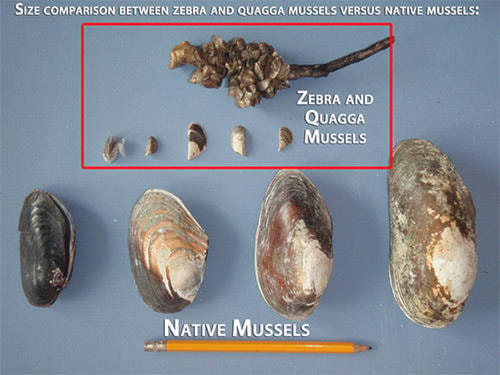The Village of Burns Lake has urged the provincial government to increase funding to protect B.C. lakes against the threat of zebra and quagga mussels.
These mussels are not native to North America. They were introduced by trans-continental shipping from the Baltic Sea to Canada - the Great Lakes region - and the United States in the 1980s.
Although zebra and quagga mussels are not present in B.C., they have been found in Ontario, Quebec, Manitoba and over 24 American states as far west as California.
According to the provincial government, these mussels pose a serious threat to B.C.’s aquatic ecosystems, salmon populations, hydro power stations and other infrastructure facilities.
“These negative impacts will create long-term economic impacts that are likely to be more expensive than the cost of preventative measures,” said Burns Lake Mayor Chris Beach in a letter sent to the provincial government earlier this year. “On behalf of council for the Village of Burns Lake, I write to express our concern.”
“Not only are the lakes a source of beauty, they are a life link to an abundance of wildlife, and a draw for tourism,” he added.
Zebra and quagga mussels can displace native aquatic plants and wildlife, degrade the environment and affect drinking water quality. Altering aquatic food webs could result in the collapse of valuable native fish populations in B.C. such as sockeye salmon, according to the B.C. government.
In addition, they can clog pipes, water intake systems such as hydro power facilities and agriculture irrigation systems, as well as municipal water supply - increasing maintenance costs.
Unlike B.C.’s native mussels, zebra and quagga mussels attach to hard surfaces, allowing them to be moved between water bodies by boats and equipment. These small, freshwater mussels can easily attach themselves to boat hulls, trailers, motors, equipment, vegetation and other organisms.
George Heyman, Minister of Environment and Climate Change Strategy, has recently responded to Burns Lake council’s letter, saying he assures them that the protection of water resources in B.C. is a top priority for his ministry.
He noted that $1 million of dedicated annual funding has been allocated for the province’s Invasive Mussel Defence Program, which involves prevention efforts such as inspecting boats, monitoring lakes, educating the public and coordinating actions with neighbouring jurisdictions.
This program has received an additional $750,000 sourced internally from the Conservation Officer Service (COS) and $2 million from the ministry’s funding partners - BC Hydro, Fortis BC, Columbia Power Corporation and Columbia Basin Trust.
To further increase resources, the COS will acquire and train the program’s second canine officer, K9 Major, to help detect possible invasive mussels on high-risk vessels, continued Heyman.
For the 2017 season, just over 35,500 watercraft were inspected across all the inspection stations in B.C. Of the total watercraft inspected, 25 were confirmed to have adult invasive mussels. The program received advanced notification on 20 of the 25 mussel fouled boats either from another jurisdiction or by Canada Border Services Agency officers.
“The province is also assessing different program funding methods being used by other jurisdictions and how the may be applied in B.C.,” added Heyman. “Outreach and education remains a top priority for the Invasive Mussel Defence Program in 2018.”
How to identify zebra and quagga mussels
- Range in size from one millimetre to three centimetres as adults;
- Have propeller shaped shells;
- Are brown or cream coloured, and may have zebra stripes (not distinguishing feature);
- Often form in grouped clumps, like some marine mussels.
Native freshwater mussels:
- In comparison, freshwater mussels native to B.C. are much larger and have a different shape and cannot attach to hard substrate;
- Most species’ adults are far larger than zebra and quagga mussels (over three centimetres);
- Either oval or heart shaped;
- Buried, partially buried or on soft substrate or between cobbles;
- Do not form clumps or attach to vertical surfaces.
@flavio_nienow
flavionienow@gmail.com
Like us on Facebook and follow us on Twitter.
